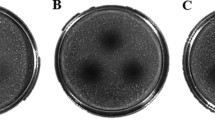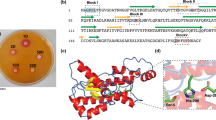Abstract
Streptomyces sp. CS-57, which was isolated from Korean soil, was found to produce phospholipase D (PLD57) as an extracellular enzyme when cultured in medium containing 2% glucose, 1.5% yeast extract, 0.5% trypton, and 0.1% calcium carbonate at 28°C, and 160-rpm. PLD57 was purified using Sepharose CL-6B column chromatography, and DEAE-Sepharose CL-6B ion exchange column chromatography. The specific activity of the purified enzyme increased 6.7 fold with 3% recovery. The purified enzyme was then analyzed using 12% SDS-PAGE, which revealed that the molecular mass of the purified enzyme was 55 kDa. PLD57 showed both hydrolytic (H) and transphosphatidylation (T) activity, and the optimum temperatures of these activities were found to be 45°C and 35°C, respectively. Similarly, both of these activities were found to be optimal at a pH of 7.5. In addition, even after being heat treated at 45°C for up to 2 h, the enzyme activity remained at 100%, and the H-activity was found to be stable at a pH of 6 to 8. Further, enzyme activity occurred in the presence of EDTA, indicating that metal ions are not required for their activity, although some metal ions did marginally increase the activity. Enzyme activity also increased by 75% in the presence of Triton-X 100 at a concentration of 0.375 %; however, none of the other detergents evaluated in this study were found to enhance enzyme activity.
Similar content being viewed by others
References
Bradford, M. M., A rapid and a sensitive method for the quantification of microgram quantities of protein utilizing the principle of protein-dye binding.Anal. Biochem., 72, 248–254 (1976).
Hammond, S. M., Altshuller, Y M., Sung, T. C, Rudge, S. A., Rose, K., Engebrecht, J., Morris, A. J., and Frohman, M. A., Human ADP-ribosylation factor-activated phosphatidylcho-line-specific phospholipase D defines a new and highly conserved gene family.J. Biol. Chem., 270, 29640–29643 (1995).
Hirsche, F. and Ulbrih-Hofmann, R., The interdependence of solvent, acceptor alcohol and enzyme source in transphos-phatidylation by phospholipase D.Biocatal. Biotrans., 18, 343–353 (2000).
Imamura, S. and Horiuti, Y, Enzymatic determination of Phospholipase D activity with choline oxidase.J. Biochem., 83, 677–680 (1978).
Juneja, L R., Hibi, N., Yamane, T., and Shimizu, S., Repeated batch and continuous operations for phosphatidylglycerol synthesis from phosphatidylcholine with immobilized phospholipase D.Appl. Microl. Biotechnol., 27, 146–151 (1987).
Juneja, L. R., Kazuoka, T., Yamane, T., and Shimizu, S., Kinetic evaluation of conversion of phosphatidylcholine to phosphatidylethanaolamine by phospholipase D from different sources.Biochim. Biophys. Acta., 960, 334–441 (1988).
Juneja, L. R., Kazuoka, T., Goto, N., Yamane, T., and Shimizu, S., Conversion of phosphatidylcholine to phosphatidylserine by various phospholipase D in the presence of L-or D- serine.Biochim. Biophys. Acta, 1003, 277–283 (1989).
Khatoon, H., Talat, S., and Yonus H., Identification and partial characterization of a highly active and stable phospholipase D fromBrassica juncea seeds.Int. J. Biol. Macromol., 40, 232–236 (2007).
Lim, S. K., Choi, J. W., Chung, M. H., Lee, E. T., and Khang, Y H., Production and characterization of extracellular phospholipase D fromStreptomyces sp. YU 100.J. Microbiol. Biotechnol., 12, 189–195 (2002).
Laemmli, U. K., Cleavage of structural proteins during the assembly of the head bacteriophage T4.Nat. London, 227, 680–685 (1970).
Liscovitch, M., Czamy, M., Fiucci, G, and Tang, X., Phospholipase D: molecular and cell biology of a novel gene family.Biochem. J., 345, 401–415 (2000).
Morris, A. J., Frohman, M. A., and Engebrecht, J., Measurement of phospholipase D activity.Anal. Biochem., 252, 1–9 (1997).
Ogino, C, Negi, Y, Daido, H., Kanemasu, M., Kondo, A., Kurodo, S., Tanizawa, K., Shimizu, N., and Fukuda, H., Identification of novel membrane-bound phospholipase D from Streptovorticillium cinnamoneum, possessing only hydrolytic activity.Biochim. Biophys. Acta, 1530, 23–31 (2001).
Pappan, K., Zheng, S., and Wang, X., Identification and characterization of a novel plant phospholipase D that requires polyphosphoinositides and submicromolar calcium for activity in Arabidopsis.J. Biol. Chem., 272, 7048–7054 (1997).
Phillis, J. W. and O’Regan, M. H.,Brain res. review, A potentially critical role of phospholipases in central nervous system ischemic, traumatic, and neurodegenerative disorder, 44, 13- 47 (2004).
Ponting, C. P. and Kerr, I. D., A novel family of phospholipase D homologues that includes phospholipid synthases and putative endonucleases: identification of duplicated repeats and potential active site residues.Protein Sci., 5, 914–922 (1996).
Saito, M., Bourque, E., and Kanfer, J., Phosphatidohydrolase and base-exchange activity of commercial phospholipase D.Arch. Biochem. Biophys., 164, 420–428 (1974).
Soucek, A., Michalec, C, and Souckova, A., Enzymic hydrolysis of sphingomycelins by a toxin ofCorynebacterium ovis.Biochim. Biophys. Acta, 144, 180–182 (1967).
Takami, M., Hidaka, N., Miki, S., and Suzuki, Y, Enzymatic synthesis of novel phosphatidylkojic acid and phosphatidylarbutin, and their inhibitory effects on tyrosinase activity.Biosci. Biotech. Biochem., 58, 1716–1717 (1994).
Virto, C, Svensson, I., and Adlercreutz, P., Hydrolytic and transphosphatidylation activities of phospholipase D from Savoy cabbage towards lysophosphatidylcholine.Chem. Phys. Lipids, 106, 41–51 (2000).
Waite, M., The PLD superfamily: insights into catalysis.Biochim. Biophys.Acta, 1439, 187–197 (1999).
Author information
Authors and Affiliations
Corresponding author
Rights and permissions
About this article
Cite this article
Simkhada, J.R., Cho, S.S., Lee, H.J. et al. Purification and biochemical properties of phospholipase d (PLD57) produced byStreptomyces sp. CS-57. Arch. Pharm. Res. 30, 1302–1308 (2007). https://doi.org/10.1007/BF02980271
Received:
Issue Date:
DOI: https://doi.org/10.1007/BF02980271




